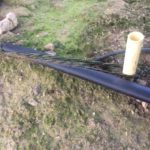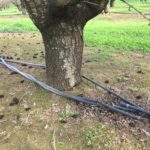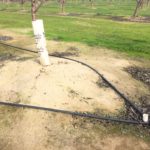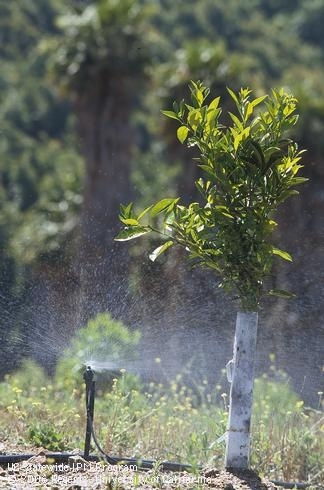While conducting surveys across Merced County, I have noticed diverse ways growers secure the ends of irrigation tubing. Many are attached using some type of stake made of wood or PVC in which the tubing is tied. Other orchards have the lines wrapped around a tree and used as an anchor for the line. Finally, some of them are staked directly into the ground.
Irrigation tubing moves because of expansion and contraction of the plastic caused by temperature changes, as well as, from the water and air moving through the irrigation system. Securing the tubing creates tension that helps prevent the tubing from moving. These keeps the emitters and microsprinkers in place which helps maintain good irrigation efficiency.
There are a few problems with securing the tubes. The first is the added cost and time to first secure the tubing and then maintain how the tubing was secured. Secondly, the lines may contract after fixing, which can pull them off the riser. Finally, the lines, if wrapped too tight, can cut into and girdle the tree. All of these are preventable.
If you do choose to secure the end of your irrigation tubing, below are some considerations to take into account:
- Leave some slack in the tubing: Due to changes in temperature, plastic tubing expands and contracts. When tightly secured tubing contracts, coupling points may become undone (e.g., at the riser) or may cause the plastic in the tubing to stretch, creating weak points that may eventually break.
- Be wary of using trees to secure tubing: While this may cut down on supply costs, make sure it does not begin to girdle the tree.
- Do it right: Since you are taking the time (and money) to secure your tubing, be sure to do it right. There is a lot of power in the contraction and expansion of irrigation tubing, and a poorly installed system will eventually fail.
- Secure irrigation tubing in the winter: Securing tubing on colder days prevents problems related to contraction. Cold tubing that does not have enough slack will just expand and create the slack that was needed. Hot tubing that does not have enough slack will contract and cause problems, as described above
- .
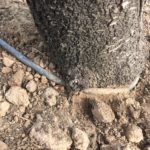
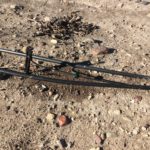
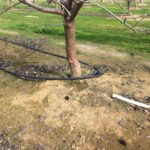
Whether or not you decide to secure your irrigation tubing is up to you. Ultimately, the end goal is a well-irrigated field. Securing irrigation tubing, if done right, is just one thing to help accomplish that goal.
From the Almond Doctor: https://ucanr.edu/sites/sayalmond/The_Almond_Doctor/
